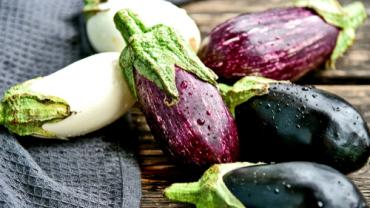
There’s a reason nutrition experts advocate eating a variety of brightly colored vegetables and fruit. Each color represents different plant compounds that have beneficial properties for health. One such category of healthful phytochemicals is anthocyanins. These are flavonoid compounds that give fruits and vegetables red, purple and blue colors. When you think of these colors, blueberries, blackberries, raspberries and beets probably come to mind first. Another plant food whose purple color indicates a high anthocyanin content, but which is often left out of discussions about the benefits thereof, is eggplant.
Although eggplant is typically considered a vegetable, botanically speaking, it’s technically a fruit! And while you might automatically associate eggplant with tomato sauce and mozzarella cheese, parmigiana style, eggplant is actually native to India and Asia, where it was cultivated for thousands of years before it ever graced the tables of Italian trattorias.
Eggplant comes in a staggering variety of shapes, sizes and colors, but the one North American consumers are most familiar with is the globe eggplant—a relatively large, heavy specimen, the skin of which is dark purple, almost black. Most supermarkets carry only this particular kind, but many others are available at farmers’ markets and Asian grocery stores. Japanese eggplant is longer, thinner, and lighter in color, and may also be somewhat curved. Chinese eggplant more closely resembles the Japanese variety than the globes, but they are even lighter purple and tend to be straighter. There are even white eggplants, varieties that are round, green and striped, and the eye-catching graffiti eggplant, which has an enticing purple and white striped skin. The smaller, thinner and oblong varieties tend to have fewer seeds and be slightly less bitter than the common globes.
With so many distinctive varieties, it’s not surprising that eggplant is employed in many different ethnic cuisines. There’s baba ganoush, the pureed eggplant spread popular in Middle Eastern cooking; grilled eggplant with yogurt and mint to round out a platter of Greek mezze; and seared Chinese eggplant with spicy garlic, ginger, and soy sauce.
If eggplant’s prominence in these delicious dishes isn’t enough to spark an interest in reaching for it at the store more often, maybe its antioxidant benefits will convince you that it’s a worthwhile addition to your culinary repertoire. Anthocyanins extracted from eggplant skin have been shown to be potent antioxidants, and they protect against damage to the fragile fats that make up cell membranes. One particular anthocyanin, called nasunin, has shown the potential to limit the growth of new blood vessels (called angiogenesis)—a process that may contribute to many conditions of compromised health.
Many eggplant recipes call for peeling the eggplant, since the skins tend to be bitter and may give a finished dish a chunkier texture than is desired. Remember, though, that the protective phytochemical compounds are concentrated in the peel. (They are, after all, what gives the eggplant its bold color.) So consider leaving the skin on—it makes dishes look more rustic and homemade anyway!
While eggplant’s anthocyanin and antioxidant content make this vegetable a welcome addition to meals, truth be told, it’s not exactly bursting with nutrients. The only thing it has going for it in any appreciable quantity is manganese: 100g of eggplant provides 13% of the daily value for this mineral. But a lack of vitamins and minerals shouldn’t be a deal-breaker. Eggplant is extremely low in calories and carbohydrates and is high in fiber. An entire pound of eggplant comes in at around 100 calories, meaning that you could fill up on generous helpings of this high water content vegetable without racking up calories. With just 6g of total carbohydrate—3g of which are fiber—the glycemic load of eggplant is 1—practically negligible. These properties help eggplant fit in perfectly with an eclectic mix of dietary approaches, including low-carb, Paleo, vegetarian, Mediterranean and more. However, individuals with sensitivity to nightshade vegetables (a category that includes eggplant, tomatoes, white potatoes and all peppers) might do well to avoid eggplant. (Nightshades are known to exacerbate the signs and symptoms of arthritis.)
The fact that eggplant has such a mild flavor of its own means that it pairs well with other ingredients, which make it a nice blank canvas to use as a base for more nutrient-dense and health-promoting items, such as garlic, olive oil, tomatoes, lamb, and feta cheese.
Sources: